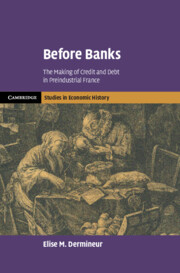Refine search
Actions for selected content:
153 results
4 - Little Land Banks: The Mortgaging Revolution and Savings on Bond
-
- Book:
- The Capitalist Self
- Published online:
- 12 October 2025
- Print publication:
- 30 October 2025, pp 165-196
-
- Chapter
- Export citation
7 - The Transformation of Legal Culture
-
- Book:
- The Capitalist Self
- Published online:
- 12 October 2025
- Print publication:
- 30 October 2025, pp 279-302
-
- Chapter
- Export citation

Prison and the Novel in Eighteenth-Century Britain
- Form and Reform
-
- Published online:
- 16 October 2025
- Print publication:
- 30 October 2025
8 - Commerce and Money Management
-
- Book:
- The Experience of Work in Early Modern England
- Published online:
- 19 September 2025
- Print publication:
- 09 October 2025, pp 285-314
-
- Chapter
-
- You have access
- Open access
- HTML
- Export citation
Martyrs, Dreams, and Past Lives: Insurgent Immortality and the Expansive Logic of Debt
-
- Journal:
- Comparative Studies in Society and History , First View
- Published online by Cambridge University Press:
- 26 September 2025, pp. 1-25
-
- Article
-
- You have access
- Open access
- HTML
- Export citation
Chapter 17 - The Uncertainty of Coming Times in Contemporary Irish Fiction
- from Part IV - Revivalist Futures
-
-
- Book:
- The Revival in Irish Literature and Culture
- Published online:
- 04 September 2025
- Print publication:
- 18 September 2025, pp 341-359
-
- Chapter
- Export citation
7 - The Economics of Climate Change
-
- Book:
- From Crisis to Action
- Published online:
- 15 August 2025
- Print publication:
- 04 September 2025, pp 143-175
-
- Chapter
-
- You have access
- Open access
- HTML
- Export citation
Some intergenerational arithmetic to control public debt in the EU
-
- Journal:
- Journal of Pension Economics & Finance , First View
- Published online by Cambridge University Press:
- 27 August 2025, pp. 1-18
-
- Article
-
- You have access
- Open access
- HTML
- Export citation
Chapter 1 - Depopulation, Debt, and Distrust
-
- Book:
- Time and Governance in Fifteenth-Century Perpignan
- Published online:
- 26 July 2025
- Print publication:
- 14 August 2025, pp 11-38
-
- Chapter
- Export citation
Chapter 3 - Generosity and Gratitude
- from Part II - Virtues of Direct Caring
-
- Book:
- Attention to Virtues
- Published online:
- 25 July 2025
- Print publication:
- 14 August 2025, pp 39-64
-
- Chapter
- Export citation
Understanding debt in the older population
-
- Journal:
- Journal of Pension Economics & Finance , First View
- Published online by Cambridge University Press:
- 15 July 2025, pp. 1-18
-
- Article
-
- You have access
- Open access
- HTML
- Export citation

Before Banks
- The Making of Credit and Debt in Preindustrial France
-
- Published online:
- 27 June 2025
- Print publication:
- 23 January 2025
Epilogue
-
- Book:
- Gift and Grit
- Published online:
- 26 May 2025
- Print publication:
- 12 June 2025, pp 212-222
-
- Chapter
- Export citation
Introduction
-
- Book:
- Gift and Grit
- Published online:
- 26 May 2025
- Print publication:
- 12 June 2025, pp 1-22
-
- Chapter
- Export citation
Feasibility and potential effects of a combined money advice and psychological therapy intervention within National Health Service Talking Therapies services
-
- Journal:
- BJPsych Open / Volume 11 / Issue 4 / July 2025
- Published online by Cambridge University Press:
- 11 June 2025, e120
-
- Article
-
- You have access
- Open access
- HTML
- Export citation
Contracts, Treaties and Relationships: Collective Debt, Collective Responsibility and Contractarian Confusions
-
- Journal:
- Canadian Journal of Political Science/Revue canadienne de science politique / Volume 58 / Issue 2 / June 2025
- Published online by Cambridge University Press:
- 09 June 2025, pp. 319-338
-
- Article
- Export citation

Gift and Grit
- Race, Sports, and the Construction of Social Debt
-
- Published online:
- 26 May 2025
- Print publication:
- 12 June 2025
A note on the size distribution of government debt
-
- Journal:
- Macroeconomic Dynamics / Volume 29 / 2025
- Published online by Cambridge University Press:
- 14 May 2025, e101
-
- Article
-
- You have access
- Open access
- HTML
- Export citation
2 - The Parable of the Two Debtors (Lk 7:36–42)
-
- Book:
- Luke's Unique Parables
- Published online:
- 28 February 2025
- Print publication:
- 06 March 2025, pp 17-21
-
- Chapter
-
- You have access
- HTML
- Export citation
3 - Counting the Pennies
-
- Book:
- Money and Irish Catholicism
- Published online:
- 20 February 2025
- Print publication:
- 27 February 2025, pp 95-128
-
- Chapter
- Export citation
